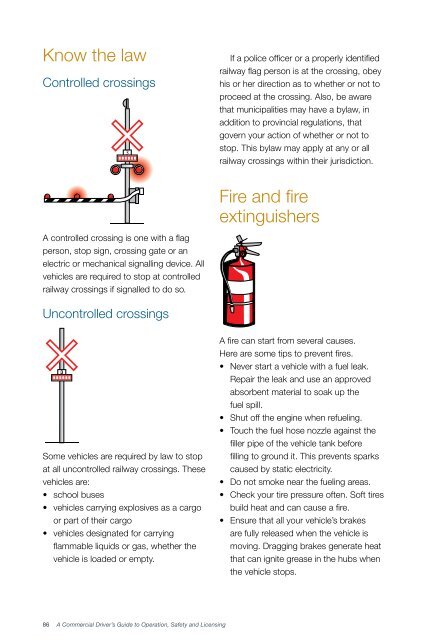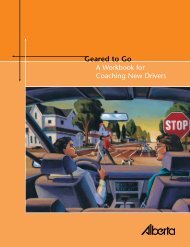Commercial driver's guide to operation, safety and licensing
Commercial driver's guide to operation, safety and licensing
Commercial driver's guide to operation, safety and licensing
Create successful ePaper yourself
Turn your PDF publications into a flip-book with our unique Google optimized e-Paper software.
Know the law<br />
Controlled crossings<br />
3<br />
If a police officer or a properly identified<br />
railway flag person is at the crossing, obey<br />
his or her direction as <strong>to</strong> whether or not <strong>to</strong><br />
proceed at the crossing. Also, be aware<br />
that municipalities may have a bylaw, in<br />
addition <strong>to</strong> provincial regulations, that<br />
govern your action of whether or not <strong>to</strong><br />
s<strong>to</strong>p. This bylaw may apply at any or all<br />
railway crossings within their jurisdiction.<br />
A controlled crossing is one with a flag<br />
person, s<strong>to</strong>p sign, crossing gate or an<br />
electric or mechanical signalling device. All<br />
vehicles are required <strong>to</strong> s<strong>to</strong>p at controlled<br />
railway crossings if signalled <strong>to</strong> do so.<br />
Fire <strong>and</strong> fire<br />
extinguishers<br />
Uncontrolled crossings<br />
Some vehicles are required by law <strong>to</strong> s<strong>to</strong>p<br />
at all uncontrolled railway crossings. These<br />
vehicles are:<br />
• school buses<br />
• vehicles carrying explosives as a cargo<br />
or part of their cargo<br />
• vehicles designated for carrying<br />
flammable liquids or gas, whether the<br />
vehicle is loaded or empty.<br />
A fire can start from several causes.<br />
Here are some tips <strong>to</strong> prevent fires.<br />
• Never start a vehicle with a fuel leak.<br />
Repair the leak <strong>and</strong> use an approved<br />
absorbent material <strong>to</strong> soak up the<br />
fuel spill.<br />
• Shut off the engine when refueling.<br />
• Touch the fuel hose nozzle against the<br />
filler pipe of the vehicle tank before<br />
filling <strong>to</strong> ground it. This prevents sparks<br />
caused by static electricity.<br />
• Do not smoke near the fueling areas.<br />
• Check your tire pressure often. Soft tires<br />
build heat <strong>and</strong> can cause a fire.<br />
• Ensure that all your vehicle’s brakes<br />
are fully released when the vehicle is<br />
moving. Dragging brakes generate heat<br />
that can ignite grease in the hubs when<br />
the vehicle s<strong>to</strong>ps.<br />
86 A <strong>Commercial</strong> Driver’s Guide <strong>to</strong> Operation, Safety <strong>and</strong> Licensing




